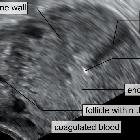first trimester
The first trimester is defined as the first 13 weeks of pregnancy following the last normal menstrual period (some authors refer to early pregnancy as 0-10 weeks). It can be divided into a number of phases, each of which has typical clinical issues. These phases are:
- conception usually occurs ~2 weeks after a woman's last menstrual period (LMP) and the gestational sac is usually too small to be seen for ~3 weeks
During the first trimester, the pregnancy progresses from a tiny gestational sac with no visible embryo, to an ~80 mm fetus with identifiable features and internal organs. For a more detailed look at the stages of the first trimester see: ultrasound findings in early pregnancy
Ultrasound during this period is predominantly concerned with the following clinical issues:
- confirming intrauterine pregnancy (IUP)
- early features supportive of an intrauterine pregnancy
- dating of the pregnancy
- crown rump length (CRL) measurement is most accurate, however if no fetal pole is seen, the mean sac diameter (MSD) may be used.
- assessment of suspected early pregnancy failure
- assessment of suspected ectopic pregnancy
- antenatal screening for aneuploidy (nuchal lucency measurement)
Practical points
The earlier in pregnancy a scan is performed, the more accurate the age assignment from crown rump length. The initial age assignment should not be revised on subsequent scans .
Overall, the accuracy of sonographic dating in the first trimester is ~5 days (95% confidence range).
Siehe auch:
- early pregnancy
- nuchal translucency
- Extrauteringravidität
- CRL
- Abortus completus
- double bleb sign
- MSD
- verhaltener Abort
- Abortivei
- Abortus incompletus
- drohende Fehlgeburt
- double decidual sign
- unvermeidliche Fehlgeburt
- intra-decidual sign
und weiter:


 Assoziationen und Differentialdiagnosen zu
Assoziationen und Differentialdiagnosen zu 



